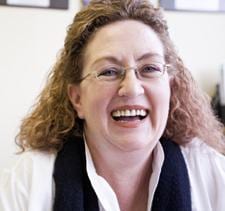The new executive director of Pride Toronto admits the organization is scrambling.
Tracey Sandilands, who started on Dec 1 after arriving from South Africa, says the absence of an executive director and other management positions has left Pride far behind where it should be.
“Essentially there was nobody running the organization for two months,” she says. “Not only was I not here but we’ve also got three other new staff members that were not here.
“The management team — the development manager, the associate director and myself — none of us were here until Nov 19 and two of us only came on the first of December. There was a real leadership and management gap so we had a huge gap in the planning process. We’re late with everything, we’re late with getting sponsors and we’re late with writing grants, some of which had to be in December.”
Partially because of that planning gap Sandilands says Pride in 2009 will not grow at all.
“We’ve decided that 2009 will be a year of consolidation,” she says. “We won’t be growing in terms of infrastructure, in terms of the number of committees and coordinators and that type of thing. Firstly because we have a time period issue, secondly because of the economic slowdown which we’re sure will impact us as well as everybody else, and because there are so many new people in the team, these are all reasons why we will deliver a festival like we did last year.”
In fact Sandilands says part of the reason for high staff turnover over the last year was the fact that Pride’s growth was not planned for.
“Last year I think they grew so much that a lot of it was done on an ad hoc basis,” she says. “I’ve heard that said by many people, that a lot of things happened on the fly almost, whereas this year we’re going to try to be prepared and know what’s going to be involved in doing the things that we want to do.”
Sandilands says she wants to expand the festival for 2010, which will be the event’s 30th anniversary.
“We’re looking at 2009 as a pilot project toward 2010,” she says. “It’s going to be the ideal opportunity to maybe introduce new features to the festival then and it gives us time to put those things in place without stretching everyone to the breaking point.”
But Sandilands says she’s not necessarily talking about making Pride physically bigger.
“I think what we have in mind is expanding its reach, reaching more people and increasing awareness and increasing publicity,” she says. “I think we’re pretty much as big as we can get in terms of size.”
Sandilands says it might be time to consider moving Pride away from its traditional location.
“There has been talk about moving the festival because it’s getting so big,” she says. “I’m not sure that will be possible in 2009 but it might be a possibility for 2010 or certainly moving components of it to different places. We’re aware of the issue that it’s outgrown the space available.”
Sandilands says she’s also determined to address the ways in which that growth may have made Pride too commercialized.
“It’s almost an occupational hazard of Prides around the world,” she says. “You need money to do what you want to do and in order to get money you need corporate sponsors. In order to fulfill the obligations in terms of the sponsorships you have to become a bit more commercial. The one thing feeds the other and it becomes a self-fulfilling prophecy.”
Sandilands says she wants sponsors to begin putting money into social activism, even if it might mean redirecting money from the stages.
“We’re looking at tying sponsorships specifically to worthy causes,” she says. “So for example we’ll go to Labatt’s, which is one of our bigger sponsors, and instead of their sponsorship just being for a stage and all the advertising and exposure they’ll get on that stage and how much product they’ll sell, their sponsorship could be directly tied to a community event, directly tied to an HIV/AIDS awareness seminar or workshop.
“At the moment, Labatt’s, we have a multi-year agreement with them so that might not be something we can change at this point. New sponsors, we’re looking at building a corporate social responsibility component into the sponsorship package precisely for that reason.”
Sandilands admits there were problems last Pride with community organization booths being shoved aside in favour of sponsors. She says part of the problem was poor planning.
“I understand that a lot of movement took place last year to try to keep everybody happy, people were shunted up and down the street and what we plan to do this year is to have that plan ready a week before the time so that all parties will have a look at it and if they have any objections there’s still a week in which to sort it out,” she says. “Maybe for every two or three paid stands, there’ll be one allocated to the community.”
She also says better planning can probably address the concerns of businesses along Church St.
“I’ve heard all sorts of horror stories, and I’ve heard of how things happened in previous years, not just last year,” she says. “I think it’s a symptom of the fact that it grew without being planned to grow as it did. But if we can get it right, it might not be a fabulous day for [the merchants] but they should be happy with the way proceedings go or they should be satisfied to close up shop and not be there.”
Sandilands says Pride needs to start seriously addressing human rights issues around the world. She dismisses the efforts Pride made in 2008 to focus on homophobia in the Caribbean.
“The plan wasn’t fully developed last year, they probably just tried to have a bit of a focus on something,” she says. “Pride Toronto is just a party, a gay party. We need to have a purpose, and I have a feeling that purpose got a bit lost.”
At the same time Sandilands says Pride needs to ask if it’s gotten too far away from sex.
“It may be well be something we should look at,” she says. “If it is the case, why is it the case? Is it because we’re afraid to offend the mainstream public? Is it because we’re trying to fit in? Is it because we’re just being respectful of other peoples’ beliefs and preferences?”


 Why you can trust Xtra
Why you can trust Xtra


